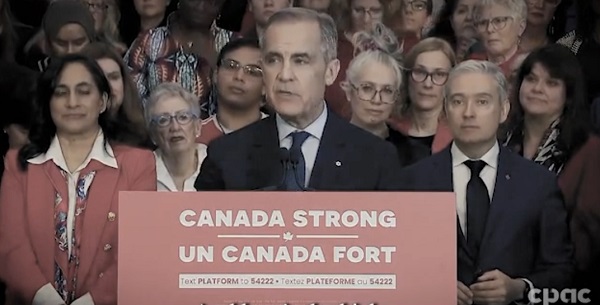Alberta
Watch Premier Kenney release details on Alberta’s COVID cases

From The Province of Alberta
COVID-19 modelling data released
Modelling projections for COVID-19 highlight the importance of continuing aggressive countermeasures to protect the lives and livelihoods of Albertans in order to stop the pandemic and restart the economy.
Alberta Health’s modelling projections indicate total cases range from 800,000 to one million infections, from mild and undiagnosed to detected, confirmed and treated, under two provincial scenarios. The Government of Alberta is advising that existing public health orders could be in place until the end of May to protect the health and safety of Albertans.
“I know these numbers can be overwhelming. But these models are not a done deal. I want Albertans to see them as a challenge. Perhaps the greatest challenge of our generation. The modelling helps us anticipate and prepare for the demands on Alberta’s health-care system so we can ensure we are prepared to support patients at the peak of the pandemic and beyond.”
Both scenarios estimate that after the virus reaches its peak, the number of cases will decline over the summer months. Without any provincial interventions to manage the pandemic response, projections show that about 13,000 Albertans could have been hospitalized with 3,900 requiring intensive care.
“COVID-19 presents an unprecedented challenge to our healthcare system. Our government has taken and continues to take aggressive measures to make sure the health-care system is ready”.
The modelling helps us anticipate and prepare for the demands on Alberta’s health-care system. Alberta Health has been scaling up the capacity of the province’s health care system by expanding the capacity of hospitals, opening up more acute care beds, intensive care unit spaces, and ventilators. These measures will ensure that under both provincial scenarios, our health-care system is prepared to support patients at the peak of the pandemic.
“We are actively increasing capacity in Alberta Health Services facilities by postponing non-urgent surgeries and diagnostic imaging, reducing a number of non-emergency services offered in hospitals, relocating patients to continuing care spaces where possible, and enhancing the use of videoconferencing and telephone care to connect physicians and health professionals with patients remotely. With these measures, and because of the hard work of our front-line health-care workers – our nurses, doctors and those who support them – we are well-positioned to manage the probable impacts of COVID-19 in the coming months.”
Quick facts
- The model uses several key assumptions, including:
- not all cases are detected
- transmission is more common within an age group, rather than between age groups
- there is no asymptomatic transmission
- people are infectious for five to 10 days
- all ICU patients require ventilation
- overall 14 per cent of cases are hospitalized and 5 per cent require ICU, but this varies significantly by age
- All Albertans have a responsibility to help prevent the spread. Take steps to protect yourself and others:
- Practise social distancing.
- Stay home and away from others if sick or in mandatory self-isolation.
- Practise good hygiene – wash hands often for at least 20 seconds, cover coughs and sneezes, and avoid touching your face.
- Monitor for symptoms, such as cough, fever, fatigue or difficulty breathing.
- Anyone who has health concerns or is experiencing symptoms of COVID-19 should complete an online COVID-19 self-assessment.
- For recommendations on protecting yourself and your community, visit alberta.ca/COVID19.
5 Recommendations to encourage us in the time of COVID from Dr. Abdu Sharkawy
Alberta
CPP another example of Albertans’ outsized contribution to Canada

From the Fraser Institute
By Tegan Hill
Amid the economic uncertainty fuelled by Trump’s trade war, its perhaps more important than ever to understand Alberta’s crucial role in the federation and its outsized contribution to programs such as the Canada Pension Plan (CPP).
From 1981 to 2022, Albertan’s net contribution to the CPP—meaning the amount Albertans paid into the program over and above what retirees in Alberta received in CPP payments—was $53.6 billion. In 2022 (the latest year of available data), Albertans’ net contribution to the CPP was $3.0 billion.
During that same period (1981 to 2022), British Columbia was the only other province where residents paid more into the CPP than retirees received in benefits—and Alberta’s contribution was six times greater than B.C.’s contribution. Put differently, residents in seven out of the nine provinces that participate in the CPP (Quebec has its own plan) receive more back in benefits than they contribute to the program.
Albertans pay an outsized contribution to federal and national programs, including the CPP because of the province’s relatively high rates of employment, higher average incomes and younger population (i.e. more workers pay into the CPP and less retirees take from it).
Put simply, Albertan workers have been helping fund the retirement of Canadians from coast to coast for decades, and without Alberta, the CPP would look much different.
How different?
If Alberta withdrew from the CPP and established its own standalone provincial pension plan, Alberta workers would receive the same retirement benefits but at a lower cost (i.e. lower CPP contribution rate deducted from our paycheques) than other Canadians, while the contribution rate—essentially the CPP tax rate—to fund the program would likely need to increase for the rest of the country to maintain the same benefits.
And given current demographic projections, immigration patterns and Alberta’s long history of leading the provinces in economic growth, Albertan workers will likely continue to pay more into the CPP than Albertan retirees get back from it.
Therefore, considering Alberta’s crucial role in national programs, the next federal government—whoever that may be—should undo and prevent policies that negatively impact the province and Albertans ability to contribute to Canada. Think of Bill C-69 (which imposes complex, uncertain and onerous review requirements on major energy projects), Bill C-48 (which bans large oil tankers off B.C.’s northern coast and limits access to Asian markets), an arbitrary cap on oil and gas emissions, numerous other “net-zero” targets, and so on.
Canada faces serious economic challenges, including a trade war with the United States. In times like this, it’s important to remember Alberta’s crucial role in the federation and the outsized contributions of Alberta workers to the wellbeing of Canadians across the country.
Alberta
Made in Alberta! Province makes it easier to support local products with Buy Local program

Show your Alberta side. Buy Local. |
When the going gets tough, Albertans stick together. That’s why Alberta’s government is launching a new campaign to benefit hard-working Albertans.
Global uncertainty is threatening the livelihoods of hard-working Alberta farmers, ranchers, processors and their families. The ‘Buy Local’ campaign, recently launched by Alberta’s government, encourages consumers to eat, drink and buy local to show our unified support for the province’s agriculture and food industry.
The government’s ‘Buy Local’ campaign encourages consumers to buy products from Alberta’s hard-working farmers, ranchers and food processors that produce safe, nutritious food for Albertans, Canadians and the world.
“It’s time to let these hard-working Albertans know we have their back. Now, more than ever, we need to shop local and buy made-in-Alberta products. The next time you are grocery shopping or go out for dinner or a drink with your friends or family, support local to demonstrate your Alberta pride. We are pleased tariffs don’t impact the ag industry right now and will keep advocating for our ag industry.”
Alberta’s government supports consumer choice. We are providing tools to help folks easily identify Alberta- and Canadian-made foods and products. Choosing local products keeps Albertans’ hard-earned dollars in our province. Whether it is farm-fresh vegetables, potatoes, honey, craft beer, frozen food or our world-renowned beef, Alberta has an abundance of fresh foods produced right on our doorstep.
Quick facts
- This summer, Albertans can support local at more than 150 farmers’ markets across the province and meet the folks who make, bake and grow our food.
- In March 2023, the Alberta government launched the ‘Made in Alberta’ voluntary food and beverage labelling program to support local agriculture and food sectors.
- Through direct connections with processors, the program has created the momentum to continue expanding consumer awareness about the ‘Made in Alberta’ label to help shoppers quickly identify foods and beverages produced in our province.
- Made in Alberta product catalogue website
Related information
-

 2025 Federal Election2 days ago
2025 Federal Election2 days agoCarney’s Fiscal Fantasy: When the Economist Becomes More Dangerous Than the Drama Teacher
-

 International15 hours ago
International15 hours agoPope Francis has died aged 88
-

 2025 Federal Election14 hours ago
2025 Federal Election14 hours agoCarney’s budget means more debt than Trudeau’s
-

 2025 Federal Election2 days ago
2025 Federal Election2 days agoA Perfect Storm of Corruption, Foreign Interference, and National Security Failures
-

 Business15 hours ago
Business15 hours agoCanada Urgently Needs A Watchdog For Government Waste
-

 2025 Federal Election2 days ago
2025 Federal Election2 days agoCampaign 2025 : The Liberal Costed Platform – Taxpayer Funded Fiction
-

 Energy14 hours ago
Energy14 hours agoIndigenous-led Projects Hold Key To Canada’s Energy Future
-

 International11 hours ago
International11 hours agoPope Francis Dies on Day after Easter






